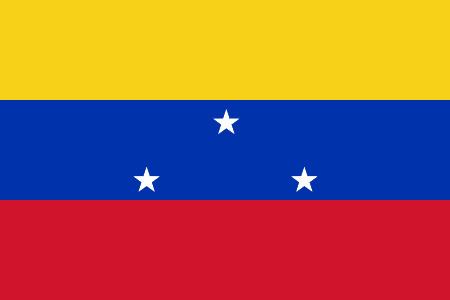Languages Spanish Government Republic 1994–1999 Rafael Caldera Capital Caracas Currency Venezuelan bolívar | Religion Catholic (around 92%) 1959–1964 Rómulo Betancourt Legislature Congress of Venezuela Founded 1958 Date dissolved 1999 | |
 | ||
The Fourth Republic of Venezuela was the period of Venezuela's history that began with the fall of the dictatorship of General Marcos Pérez Jiménez and ended with the 1999 Constituent Assembly and the establishment of the present-day Bolivarian Republic of Venezuela, or Fifth Republic.
Contents
The Fourth Republic was characterised by the alternation of political power established in the Punto Fijo Pact; by the nationalisation of the oil industry in 1976 and the creation of PDVSA, the national oil and gas company; and by the rise of new social elites. Internationally, Venezuela became a founding member of the Organization of the Petroleum Exporting Countries (OPEC).
The 1980s in particular were characterised by the flowering of art and culture and by the artistic development of the nation, especially in television. Pioneering media like RCTV made Venezuela famous with soap operas such as Kassandra.
History
After a military coup d'état on 23 January 1958 sent General Marcos Pérez Jiménez into exile, Venezuela's three main political parties signed the Punto Fijo Pact. The ensuing elections brought Rómulo Betancourt, who had been president from 1945 to 1948, back to power. Betancourt's government halted grants to multinational oil companies, created a Venezuelan oil corporation, and helped establish OPEC in 1960, an initiative led by Development Minister Juan Pablo Pérez Alfonso. The administration also introduced a new constitution in 1961, dividing the government into executive, legislative, and judicial branches; pursued agricultural reform; and promoted an international doctrine in which Venezuela only recognised governments elected by popular vote.
The new order had its opponents. On 24 June 1960, Betancourt was wounded in an assassination attempt led by the Dominican dictator Rafael Leónidas Trujillo. Around the same time, the left-wingers excluded from the Punto Fijo Pact began an armed insurrection that was backed by the Communist Party of Cuba and its leader, Fidel Castro.
In 1963, Raúl Leoni was elected to succeed Betancourt as president. Leoni's government became known for public works and cultural development, but was confronted with continuous guerrilla warfare.
Rafael Caldera won the next election. Before he took office in 1969, the Rupununi uprising broke out in neighboring Guyana, creating an opportunity for Venezuela to claim the Esequiba region. The border controversy was resolved with the Port of Spain Protocol in 1970. Additionally, a truce with the guerrillas allowed their reintegration into political life.
Carlos Andrés Pérez took office in 1974, amid an oil crisis that had begun the previous year and had increased the global price of oil from $3 per barrel to nearly $12 per barrel. Venezuela nationalised its iron industry in 1975 and its oil industry the following year.
Luis Herrera Campins was elected to the presidency in 1979, with the country in deep debt and bound by International Monetary Fund demands. In 1983, the Venezuelan currency, the bolívar, was devalued on what became known as Black Friday, unleashing an economic crisis. The subsequent government of Jaime Lusinchi did little to counter the crisis. Corruption increased, and the Caldas Corvettes crisis in 1987, sparked by a sovereignty dispute in the Gulf of Venezuela, generated one of the biggest moments of tension between Venezuela and Colombia.
Pérez was elected again in 1988 and, looking to solve the recession, adopted economic measures that set off major protests, the biggest of which was the Caracazo wave of 1989. The same year, Venezuela held its first direct elections of governors and regional mayors.
In February and November 1992, Hugo Chávez led two coup d'état attempts, and in 1993, Congress ousted Pérez. Octavio Lepage served as acting president for about two weeks, at which point the historian and parliamentarian Ramón José Velásquez took over the interim role.
Caldera assumed the presidency for the second time in 1994 and was quickly faced with a banking crisis. Chávez gained popularity amid the financial turmoil and was elected president in 1998. His administration promoted a new constitution, which was approved by referendum in December 1999. The adoption of the new constitution ended the Fourth Republic, and the country took on its current name, the Bolivarian Republic of Venezuela, an homage to Simón Bolívar.
Territorial organisation
The constitution of 1961 divided Venezuela into states, a capital district, federal territories, and federal dependencies. Over the years, some territories have been elevated to the status of states, including Delta Amacuro in 1991 and Amazonas in 1994. Each state has a governor and a legislative assembly.
Science and technology
Significant advances in the medical sciences took place during the Fourth Republic period. Jacinto Convit developed vaccines against leprosy and leishmaniasis, and Baruj Benacerraf was a co-recipient of the Nobel Prize in Physiology or Medicine in 1980 for his immunological research. In the field of technology, Humberto Fernández Morán invented the diamond knife and contributed to the development of the electron microscope.
Culture
The 1980s and 1990s were also a golden age of television in Venezuela. A number of Venezuelan telenovelas became popular internationally: Leonela (1983), Cristal (1984), Abigail (1988), Kassandra (1992), and Por estas calles (1992), all from RCTV; and Las Amazonas (1985), Ka Ina (1995), and El país de las mujeres (1998) from Venevisión.
Several Venezuelans won international beauty contests: Maritza Sayalero (1979), Irene Sáez (1981), Bárbara Palacios Teyde (1986), and Alicia Machado (1996). Musicians like Franco de Vita, Ricardo Montaner, and Karina also became known on the international scene.
